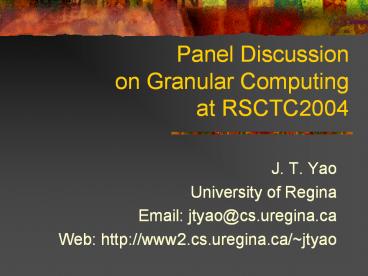Panel Discussion on Granular Computing at RSCTC2004 - PowerPoint PPT Presentation
Title:
Panel Discussion on Granular Computing at RSCTC2004
Description:
The intension of a concept consists of all properties or attributes that are ... f is the intension of the concept. m(f) is the extension of the concept ... – PowerPoint PPT presentation
Number of Views:16
Avg rating:3.0/5.0
Title: Panel Discussion on Granular Computing at RSCTC2004
1
Panel Discussion on Granular Computing at
RSCTC2004
- J. T. Yao
- University of Regina
- Email jtyao_at_cs.uregina.ca
- Web http//www2.cs.uregina.ca/jtyao
2
What is Granular Computing?
- There are three basic concepts that underline
human cognition granulation, organization and
causation. - Informally, granulation involves decomposition of
whole into parts - Organization involves integration of parts into
whole - Causation involves association of causes with
effects. - Granulation of an object A leads to a collection
of granules of A, with a granule being a clump of
points (objects) drawn together by
indistinguishability, similarity, proximity or
functionality (Zadeh 1997)
3
What is Granular Computing
- An umbrella term to cover any theories,
methodologies, techniques, and tools that make
use of granules in problem solving. - A subset of the universe is called a granule in
granular computing. - Basic ingredients of granular computing are
subsets, classes, and clusters of a universe.
4
Granule Computing and Data Mining
- A concept is understood as a unit of thoughts
that consists of two parts, the intension and
extension of the concept. - The intension of a concept consists of all
properties or attributes that are valid for all
those objects to which the concept applies. - The extension of a concept is the set of objects
or entities which are instances of the concept. - A rule can be expressed in the form, fgt?
- where f and ? are intensions of two concepts.
- Rules are interpreted using extensions of the two
concepts.
5
How do Rough Sets Contribute to Granular
Computing?
- Zadeh define Granular Computing in BISC/SIG on
GrC as a superset of the theory of fuzzy
information granulation, rough set theory and
interval computations, and is a subset of
granular mathematics.
6
Zadehs Fuzzy GrC Model
- Granules are constructed and defined based on the
concept of generalized constraints. Relationships
between granules are represented in terms of
fuzzy graphs or fuzzy if then rules. - A granule is defined by a fuzzy set G X X
isr R
7
Pawlaks Rough Set Model
- Granulation Universe gt granules
- Some granules can only be approximately
described. - Rough sets can deal with approximation of
information granulation. - In the case one cannot describe X using E
8
Information Tables
- U a finite nonempty set of objects.
- At a finite nonempty set of attributes.
- L a language defined using attributes in At.
- Va a nonempty set of values for a ? At
- Ia U ? Va is an information function.
9
Concept Formation
- Atomic formula av (a ? At, v ? Va )
- If f, ? are formulas, so is f? ?
- If a formula is a conjunction of atomic formulas
we call it a conjunctor. - Meaning of a formula
- m(f)x ? U x ? f
- x ? av iff Ia(x)v
- A definable concept is a pair (f, m(f))
- f is the intension of the concept
- m(f) is the extension of the concept
10
Classification Problems
- Assume that each object is associated with a
unique class label. - Objects are divided into disjoint classes which
form a partition of the universe. - The set of attributes is expressed as At F ?
class, where F is the set of attributes used to
describe the objects. - To find classification rules of the form, f ?
class ci, where f is a formula over F and ci is
a class label.
11
Solution to Classification Problems
- The partition solution to a consistent
classification problem is a conjunctively
definable partition p such that p ? pclass. - The covering solution to a consistent
classification problem is a conjunctively
definable covering ? such that ? ? pclass.
12
A construction algorithm
- Construct the family of basic concept with
respect to atomic formulas - BC(U) (av, m (a v)) a ? F, v ? Va
- Set the unused basic concepts to the set of basic
concepts - UBC(U) BC(U).
- Set the granule network to GN (U,?), which is
a graph consists of only one node and no arc. - While the set of smallest granules in GN is not a
covering solution of the classification problem
do the following - Compute the fitness of each unused basic concept.
- Select the basic concept C(av, m(av)) with
maximum value of fitness. - Set UBC(U) UBC(U) - C.
- Modify the granule network GN by adding new nodes
which are the intersection of m(av) and the
original nodes of GN connect the new nodes by
arcs labelled by a v.
13
References
- Pawlak, Z., Granularity of knowledge,
indiscernibility and rough sets, IEEE
International Conference on Fuzzy Systems,
106-110, 1998. - Yao, J.T., Yao, Y.Y. A granular computing
approach to machine learning, FSKD'02, 732-736,
2002. - Yao, Y.Y. Granular computing basic issues and
possible solutions, JCIS (I), 86-189, 2000. - Zadeh, L.A. Towards a theory of fuzzy information
granulation and its centrality in human reasoning
and fuzzy logic, Fuzzy Sets and Systems, 19,
111-127, 1997.































